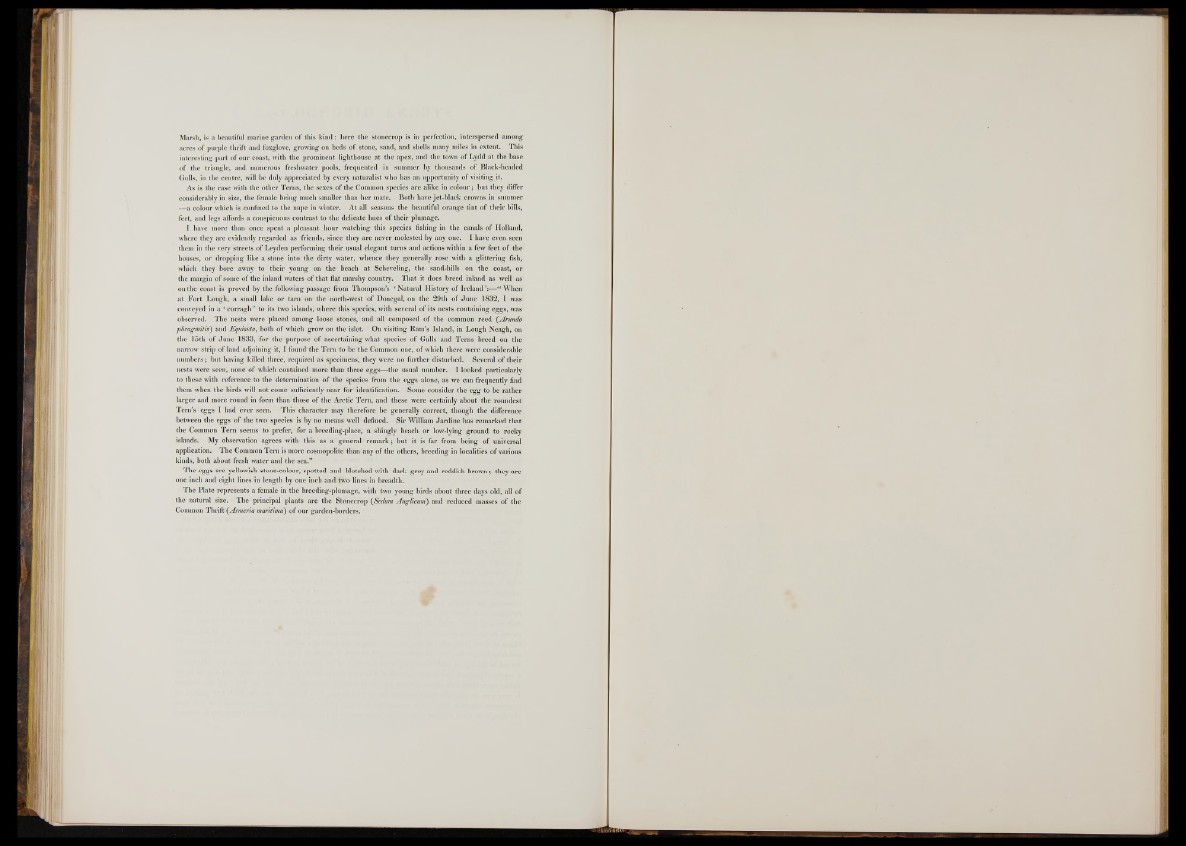
Marsh, is a beautiful marine garden o f this kind: here the stonecrop is in perfection, interspersed among
acres of purple thrift and foxglove, growing on beds o f stone, sand, and shells many miles in extent. This
interesting part o f our coast, with the prominent lighthouse at the apex, and the town of Lydd at the base
of the triangle, and numerous freshwater pools, frequented in summer by thousands of Black-headed
Gulls, in the centre, will be duly appreciated by every naturalist who has an opportunity of visiting it.
As is the case with the other Terns, the sexes o f the Common species are alike in colour; but they differ
considerably in size, the female being much smaller than her mate. Both have jet-black crowns.-in summer
—a colour which is confined to the nape in winter. At all seasons the beautiful orange tint o f their bills,
feet, and legs affords a conspicuous contrast to the delicate hues o f their plumage.
I have more than once spent a pleasant hour watching this species fishing in the canals o f Holland,
where they are evidently regarded as friends, since they are never molested by any one. I have even seen
them in the very streets o f Leyden performing their usual elegant turns and actions within a few feet o f the
houses, or dropping like a stone into the dirty water, whence they generally rose with a glittering fish,
which they bore away to their young on the beach at Scheveling, the sand-hills on the coast, or
the margin of some of the inland waters o f that flat marshy country. That it does breed inland as well as
on the coast is proved by the following passage from Thompson’s ‘ Natural History o f Ireland ’S j When
at Fort Lough, a small lake or tarn on the north-west o f Donegal, on the 29th o f June 1832, I was
conveyed in a ‘ corragh ’ to its two islands, where this species, with several o f its nests containing eggs, was
observed. The nests were placed among loose stones, and all composed o f the common reed ([Arundo
phragrnitisj and Equiseta, both o f which grow on the islet. On visiting Ram’s Island, in Lough Neagh, on
the 15th o f June 1833, for the purpose o f ascertaining what species o f Gulls and Terns breed on the
narrow strip o f land adjoining it, I found the Tern to be the Common one, o f which there were considerable
numbers; but having killed three, required as specimens, they were no further disturbed. Several o f their
nests were seen, none o f which contained more than three eggs—the usual number. I looked particularly
to these with reference to the determination o f the species from the eggs alone, as we can frequently find
them when the birds will not come sufficiently near for identification. Some consider the egg to be rather
larger and more round in form than those of the Arctic Tern, and these were certainly about the roundest
Tern’s eggs I had ever seen. This character may therefore be generally correct, though the difference
between the eggs o f the two species is by no means well defined. Sir William Jardine has remarked that
the Common Tern seems to prefer, for a breeding-place, a shingly beach or low-lying ground to rocky
islands. My observation agrees with this as a general remark; hut it is far from being o f universal
application. The Common Tern is more cosmopolite than any o f the others, breeding in localities o f various
kinds, both about fresh water and the sea.”
The eggs are yellowish stone-colour, spotted and blotched with dark grey and reddish brown; they are
one inch and eight lines in length by one inch and two lines in breadth.
The Plate represents a female in the breeding-plumage, with two young birds about three days old, all of
the natural size. The principal plants are the Stonecrop (Sedum Anglicuni) and reduced masses o f the
Common Thrift (Armeria maritima) o f our garden-borders.